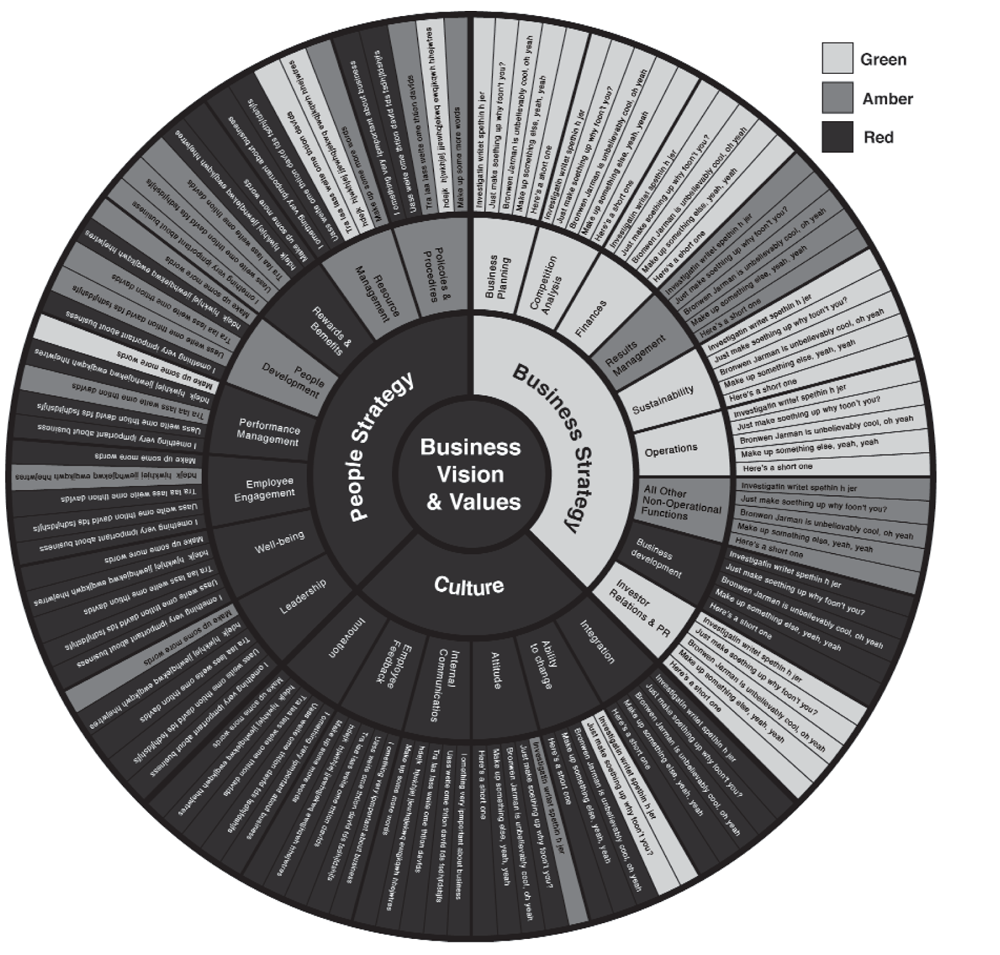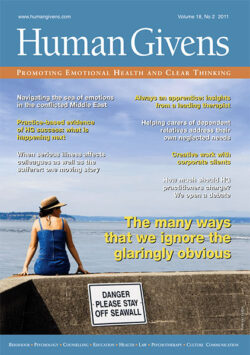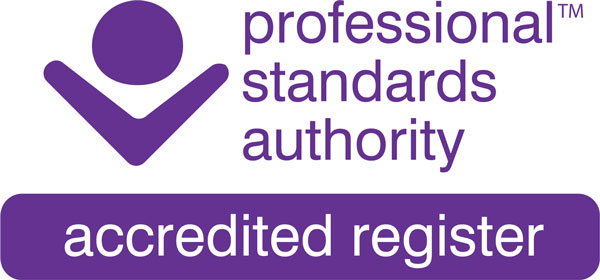Balancing up the business
Janice Haddon shows how she has drawn upon the human givens approach to work more creatively with corporate clients.
As the managing director of a business strategy, leadership development and coaching company and a holder of the Human Givens Diploma, I am only too well aware of how little emphasis many companies place on getting their employees’ needs met – not realising what a beneficial effect it would have on their balance sheets if only they were to do so.
It isn’t too hard to find statistics to support that statement. Self reported work-related stress, depression and anxiety account for 11.4 million lost working days in the UK alone.1 Work-place stress is costing £26 billion per annum in lost days, staff turnover and lower company productivity.2 Direct employee absence was nearly £17 billion in 2009, with 70 million work days lost just because of stress.3 And staff disengagement is costing the UK economy a whacking £64.7 billion per year.4
I wanted to find a way to get the benefits of the human givens approach accepted and integrated into the corporate environment, so that my clients could learn how to alleviate the pressure on their businesses and also encourage their employees to take responsibility for their wellbeing. We work with a whole variety of companies, ranging from engineering and utilities through to recruitment, motor and financial services. Some have 40 staff; some have thousands. The initial problem I encountered across the board related to language. In my experience – and I know I’m not alone, unfortunately5 – ‘human givens’ and ‘emotions’ were not words that were readily accepted within the corporate environment. By stepping into their reality, I realised the key to acceptance was the creation of some new tools, using slightly different language. So, whilst always referencing back to the human givens, I created the Life Balance and Wellbeing Audit.
The audit comprises a chart and a series of coaching questions and tools that individuals can complete for themselves or with a coach. It takes a unique approach by combining, in a structured way, the wheel of life idea, common to coaching, with our essential emotional needs. This enables an individual to drill down into a level of detail that may not be possible with either chart used separately. Everyone who completes it has to consider exactly how all their emotional needs are being met in each area of their life – career, finances, friendships, health and nutrition, physical fitness, personal growth, family, significant other, social, spiritual and physical environment – giving each a score of zero to 10. They also end up identifying and scoring how much their individual emotional needs are being met across all the areas of their lives. As they start to engage with their emotional needs, people soon come to understand what is and what isn’t working for them on a personal level.
I have often found that this detailed approach flags up difficulties that might otherwise have escaped notice. For instance, someone might score their work life at a respectable six or seven overall (they enjoy the type of work they do and they like their company and the perks it provides) but then come to realise that their work life is leaving many important needs unmet. For example, because their particular line manager is overly controlling, they may have little sense of status, little control over how they do their work, no privacy, as they are constantly watched, little sense of emotional connection because of a culture of distance, and no chance to shine and experience a sense of competence. They might have been getting their work done well enough and they might be enjoying their six weeks’ holiday a year but suddenly the migraines or the lack of energy start to make sense.
The Life Balance and Wellbeing Audit has become a tool that now forms the foundation stone for many different areas of our work, with both individuals and companies. It is invaluable in one-to-one coaching, and is at the heart of our stress management workshops and wellbeing programmes, which we have started to run incompany. The last several months have seen positive feedback for these from staff and managers alike. Not only do they benefit employees, as they learn positive approaches to their physical, nutritional and mental wellbeing, but employees also derive the pleasure of feeling cared for, through their company’s investment in them. Our feedback is that both motivation and performance are on the increase while sickness absence levels are starting to drop. Our next step is to launch a set of programmes that can be completed online – the first is a six-week total wellbeing and life balance programme, to be followed by a three-week programme for people looking for a new job. Others will be launched in due course.
The audit is also now integral to our leadership programmes. Once individuals have an appreciation of their own needs, they are taken through a series of development tools and experiential sessions to enhance their understanding of the impact that their working style may have on the essential needs of others. For instance, some directors or senior managers might feel comfortably in control of work demands and be pushing forward in a calm, motivated and effective way that makes them feel a strong sense of competence and achievement, so they will rate their work experience highly. However, they might be shocked to discover that, in being overly task oriented and target driven, they are inadvertently creating stress in others, preventing them from achieving much work satisfaction at all, and that their own satisfaction or sense of achievement is at the cost of that of others. Or it might be that some managers are dictatorial or obstructive, not because they want to ensure that things are done right but because they are insecure about some of their own abilities and have developed a work style to act as a kind of safety barrier around themselves.

When such discoveries are made at senior levels, inevitably change follows. One current client with over 300 staff has just completed a second annual employee survey, where a series of questions rating management style and employee engagement has shown a significant increase in satisfaction levels since the implementation of a leadership programme.
Treat staff right
My passion lies in ensuring that companies and managers treat their staff well and with respect and I have been glad to bring my knowledge of essential needs into the creation of a unique Business Strategy Diagnostic, which shows companies how to increase performance through balancing business and people requirements. The diagnostic takes the form of a wheel, at the centre of which sits ‘business vision and values’, surrounded by sections entitled ‘business strategy’ (covering areas such as planning, financial management, health and safety, competitor analysis, etc), ‘people strategy’ (policies and procedures, leadership, etc) and ‘culture’ (employee engagement, innovation). First, individuals or teams of senior managers are asked to identify their main aims and vision (eg to be the market leader in sector x) and specify the behaviours or qualities that the company values would embody. But whatever they specify (for example, ‘teamwork’ or ‘respect’), they then have to show how they are supporting that in their business and people strategies and within the culture of the company – how it is reflected in their policies, sustainability of staff, communication, career prospects, etc. As more and more details unfold, specific areas are given traffic light colours: red if nothing’s happening, amber if there is at least something in place and green if running well. As the wheel is completed, the visual impact of the outcome is remarkably strong. Most companies find that they are steaming well ahead on business strategy but have completely stalled on creating a people strategy and a culture where needs are perceived as met (see example below). They realise that, although they have clear expectations for profits, they have no expectations as regards, for instance, wellbeing, appropriate behaviour or how managers can effectively manage.
From the results of the completed diagnostic, a full ‘route map’ for change is created. Some companies which have engaged wholeheartedly with the system and are working with us over the long term to make significant changes are already seeing the positive bottomline effects.
My work in the field of stress management and wellbeing, and the fact that I have a research project to complete as part of my MA in Human Givens Psychotherapy, has also led me to bring the Life Balance and Wellbeing Audit out of the boardroom and into the GP surgery. The audit is currently being trialled by primary care patients to measure improvements over a 10-week period, in nutrition and physical and mental health. Results are already showing positive benefits for patients who are overweight and suffering hypertension, diabetes and depression.
What I like to stress to people, when using the audit is that they should keep their focus on the positives. I suggest that they start by looking at the areas of life with which they are most satisfied and where they have scored the highest for essential needs met. Sometimes we can be so overwhelmed by the areas that are not working that, in our rush or anxiety to fix them, we forget about the other aspects that are working well. We need to keep on doing whatever it is that is working, as that helps us generate a bit more spare capacity to tackle the rest.
I think methods based on the concept of essential needs – and I hope I have inspired some readers to come up with some ideas of their own – are a wonderfully simple tool for people to use so that, used at the right time and acted upon, they do not have to tumble into the depths of depression or mental ill health and take months or years off work. People gain clarity about where they are in their lives and learn to appreciate and capitalise on what is working well for them, whilst they decide how to improve aspects with which they are less happy. In short, such tools give people understanding, knowledge and responsibility for their own wellbeing and balance.
Janice Haddon is managing director of Morgan Redwood Ltd (www.morganredwood.com), a business strategy, leadership development and coaching company and a director in Health Matters 360, working with companies and individuals for an integrated approach to health, fitness and wellbeing in and out of the workplace. She can be contacted at jhaddon@morganredwood.com for more information.

This article first appeared in “Human Givens Journal” Volume 18 – No. 2: 2011
Back issues available – each issue of the HG Journal is jam-packed with thought-provoking articles, interviews, case histories, news, research findings, book reviews and more, with no advertising. If you find the articles, case histories and interviews on this website helpful, and would like to support the human givens approach, you can buy a back issue today, they’re available in PDF and print format.

